
How to SCALE a Facebook Ad Campaign
In this guide, I’m going to show you how to scale a Facebook ad campaign.
Let’s say that you have a campaign that’s been delivering good results and is profitable on a cost per result basis for you.
At that point, you probably want to increase the budget in order to scale it.
There are lots of competing theories about the best way to scale Facebook campaigns, but in our agency, we’ve done tons of testing and gotten real-world results.
In fact, we spend a lot more time scaling our clients campaigns than creating them in the first place. So, this is something I can help you with.
How I Approach Scaling Facebook Campaigns
I’m going to give you an example scenario and then we’ll talk through some numbers and how I like to approach doing this.
Let’s assume you’re running a campaign similar to the example one I have set up here.
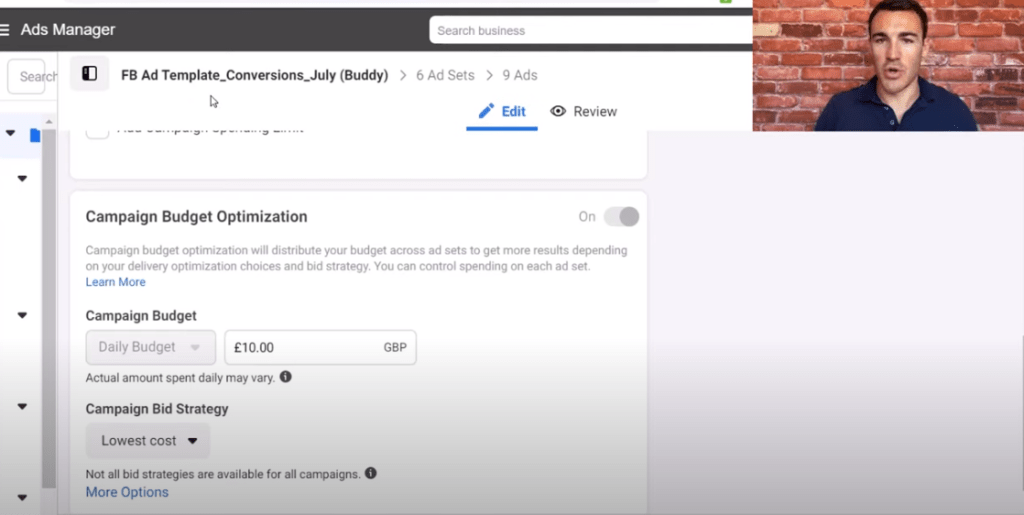
We ran this campaign previously to try and get optins for our five-part Facebook ad template.
But this strategy would apply to any direct offer campaign.
So let’s say you’re advertising a product for your new e-commerce business or that you’re advertising an offer like a free consultation and are looking to generate leads.
What I’m about to describe and demonstrate would apply to both those scenarios as well. So, it’s going to cover the vast majority of Facebook advertisers.
We’ll assume that the Facebook campaign that you’re running is nicely profitable for you. You might be running it at $10 a day or significantly larger amount.
And you might have more capacity or more stock and want to scale the campaign to increase the number of clients and customers by spending more on Facebook.
There are enormous audiences on both Facebook and Instagram, so scaling can be a complete game-changer for your business.
I’ve personally seen it so many times where companies all of a sudden start doing millions of dollars of sales every month because of scaled, high-performing Facebook ad campaigns.
The Myth: There is a lot of advice out there that says to never scale a Facebook campaign more than 20% a day. But if you are starting at $10 and want to get to $500 or even $5,000 a day in spend then going from $10 to $12 is barely going to make a difference.
We have loads of clients that have gone from $100 a day to $1,000 or $2,000 a day in spend and we’ve found that trying to do this in 20% increments just keeps the campaign in the learning phase and operating at subpar levels.
There’s no set percentage increase rule for how much you should scale a day.
I have no problem taking a campaign from £10 to £20 a day. If it’s performing very well I’ll even take it from £10 a day to £30 a day.
But I would never take a campaign from a £1,000 a day to £2,000 a day in one go, even though that’s the same percentage increase as £10 to £20.
When your spend is lower you can increase your budgets by a larger percentage than when your spend is higher.
So lets say that I’m currently spending £10 a day and my target is to spend as much as I possibly can while keeping my cost per conversion down.
The first thing I’ll do is double the budget on a low adspend.
I’m going to show you how I do this in an excel spreadsheet.
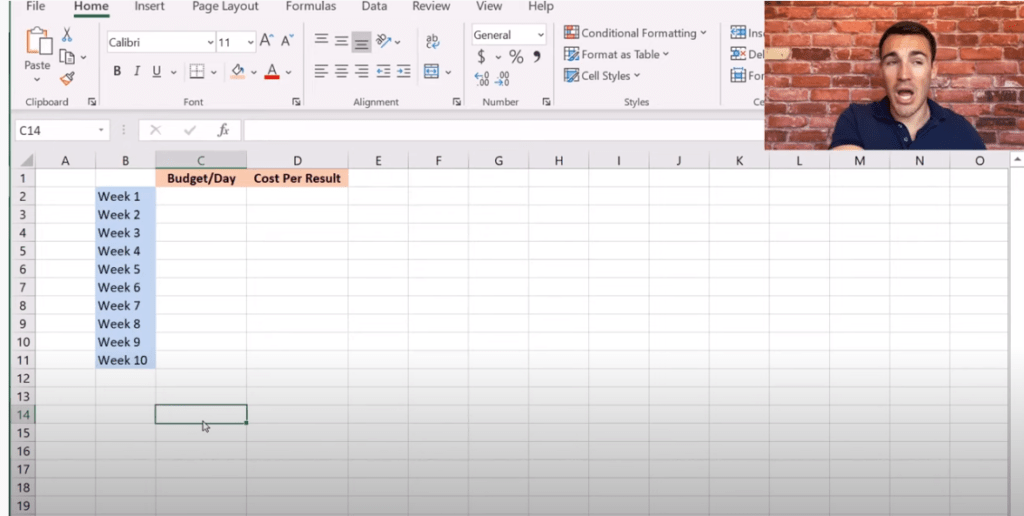
You’ll see on the left-hand side here I’ve got weeks.
That’s because in general after a budget increase I’m going to give the campaign about a week before scaling further. I need it to go through the learning phase which usually takes a couple of days and then I want enough time to get accurate data on the new budget.
I want to know the campaign can perform well at this new budget level before we make further decisions.
We’re not in here increasing the budget on a Tuesday and then again on Thursday. It’s just not enough time to get accurate results.
When you are scaling it’s CRITICAL to know how much you can afford to pay per conversion.
That way you can look at your data accurately.
Your cost per conversion target will vary depending on exactly what you’re selling.
If you’re selling a lead for a $3,000 service, then you can afford to spend more per lead or sale than someone selling a $20 e-commerce item.
So, you need to run your numbers and determine what you can actually afford to pay and what your upper limit is on your cost per conversion to keep your campaign profitable.
Additional Resources: I talk about how to set your Facebook ad budget in this post. It goes over these concepts in more detail.
In this example we’ll say that the upper limit you can spend per result to maintain profitability is $50.
You are currently spending $100 a day and your current cost per result is coming in at $25 a day.

We are well under our target result of $50 per conversion, so that’s fantastic.
We’ve established that’s the data for week one. So now we are going to do week two. I’m quite comfortable going from $100 a day to $200 a day in one go – as long as you’re advertising in a larger market.
If you’re advertising in a local market and the target audience is quite small, then you need to do this slower than what I’m demonstrating.
Often when you start scaling a campaign your cost per acquisition goes up. That’s why it’s so important to understand what your target cost is.
In this example, I’ll scale up to $200 spend per day and my cost per acquisition may rise to $30 a day.
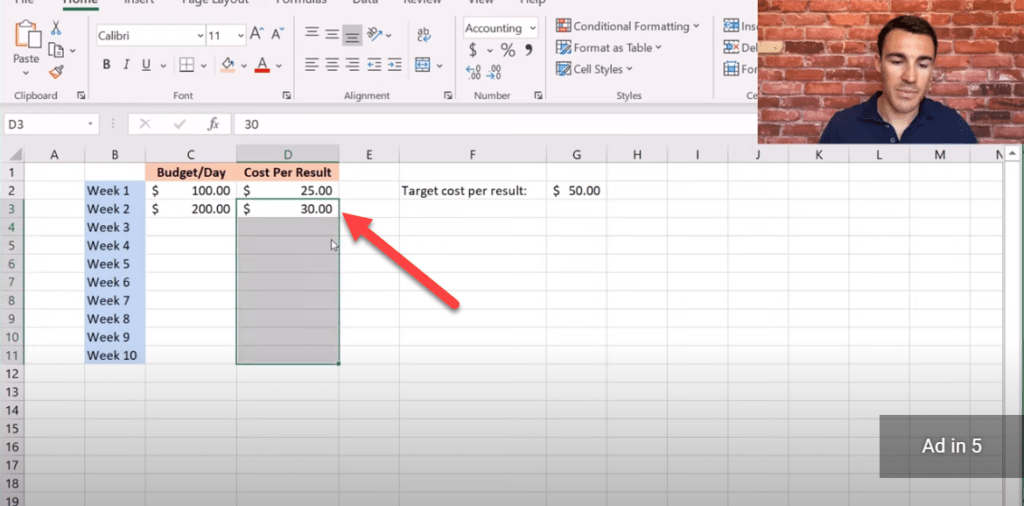
$30 a day is still quite profitable, because our target cost per result is $50. So we’re fine.
Tip: When they start to scale, many people look at the cost per result going up and they freak out a little bit. But if your cost per result is still under your target then it makes sense to continue scaling.
So what I’m going to do here is put another column in that’s called results. It shows you how many leads you generated for your spend in a week at the budget we’re at.
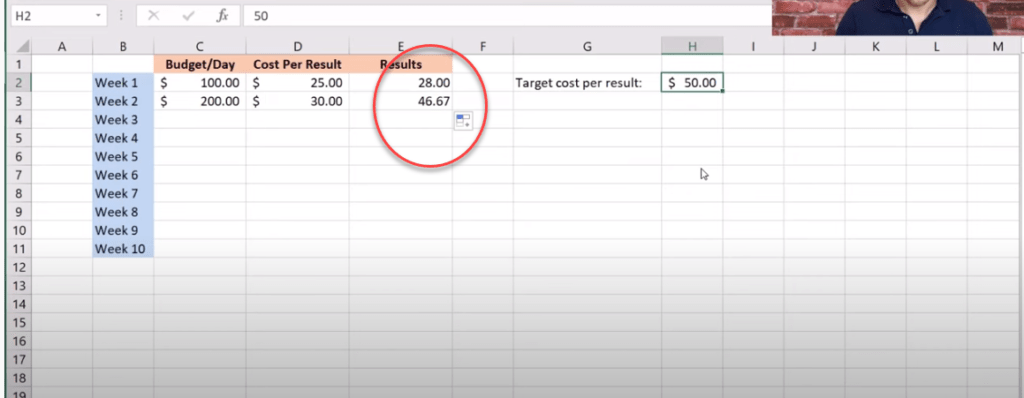
The next step is to jump up to $300 per day. I think that going from $200 to $400 may be a little bit much.
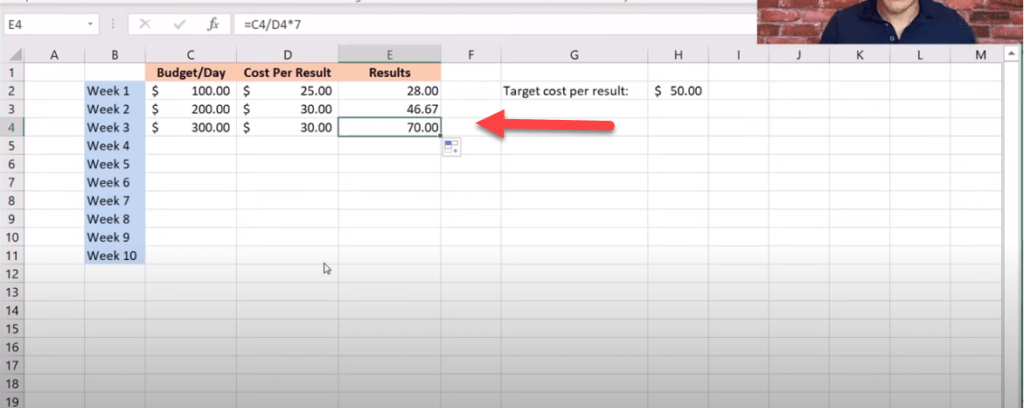
So, lets say our cost per result stays about the same here, but now we’re generating 70 leads a day.
That’s fantastic! We’re still nicely under cost and we think that’s pretty good so let’s jump up to $500 a day. We didn’t see any increase in cost per result going from $200 to $300 a day, so that’s a good indication that we can scale further.
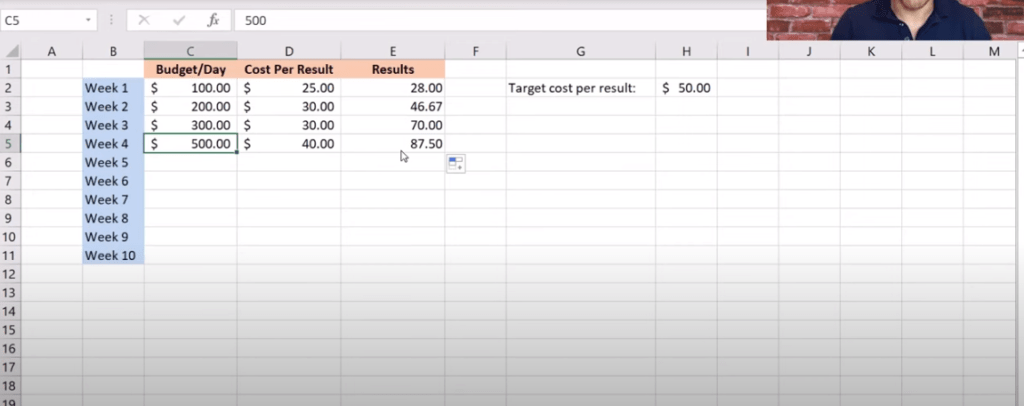
This ad spend increase jumps our cost per result up to $40.00, but that’s still under our target of $50 and we are now generating 87 leads per week.
Now, I would probably scale up to $750 a day, because I’m still under my target cost per result and I still have capacity to handle more leads.
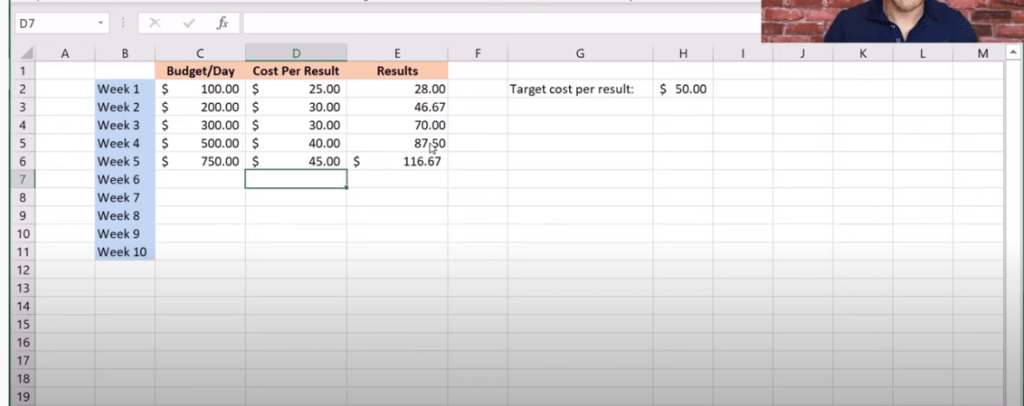
This brings me up to a cost per result of $45.00 per lead and 116 leads per week.
So, while my cost per result is still increasing every time I increase my budget I’m still under my cost per result target, so I’m not going to worry about it. The increased lead volume more than makes up for the increased lead cost
Then I’m going to scale up to $1,000 a day and this pushes me up to $55.00 cost per result.
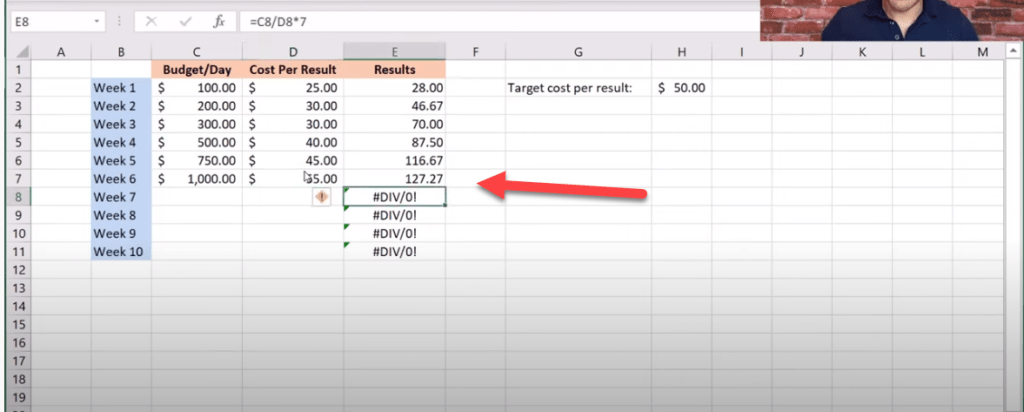
That’s above our acceptable cost per result, so something needs to change.
At this point it’s absolutely fine to decrease the budget. Scaling doesn’t always need to be straight up and sometimes we’ll scale the budget back and then scale it up again.
In this scenario, we successfully scaled our budget for five weeks, but at week six the cost per result goes too high.
So we’ll bring it back down. In this case we’ll try for something like $850 spend per day.
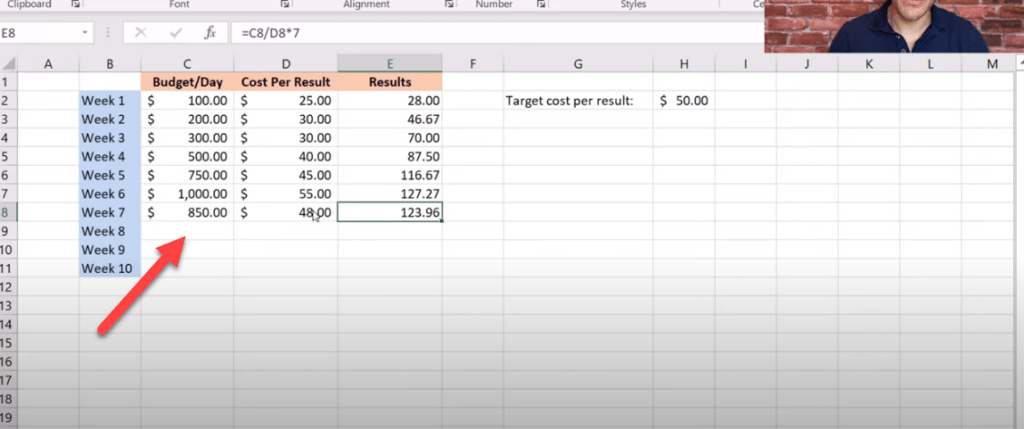
That brings us down to $48 per lead, which is an acceptable cost and we’re still generating more leads than at lower budget levels.
Right now we’ve settled in at $850 a day, but don’t think that’s the most you’ll ever be able to spend. You might need to spend some time at this budget level to allow Facebook to adjust and optimize before moving your budget up again.
Sometimes Facebook will be able to get your cost per result to come down.
You can also introduce new ad creative, targeting options, etc. that improve the performance of your campaign and bring your cost per result down.
So here were leave the budget at $850 a day for the next few weeks and the cost per result comes down from $48 to $42.
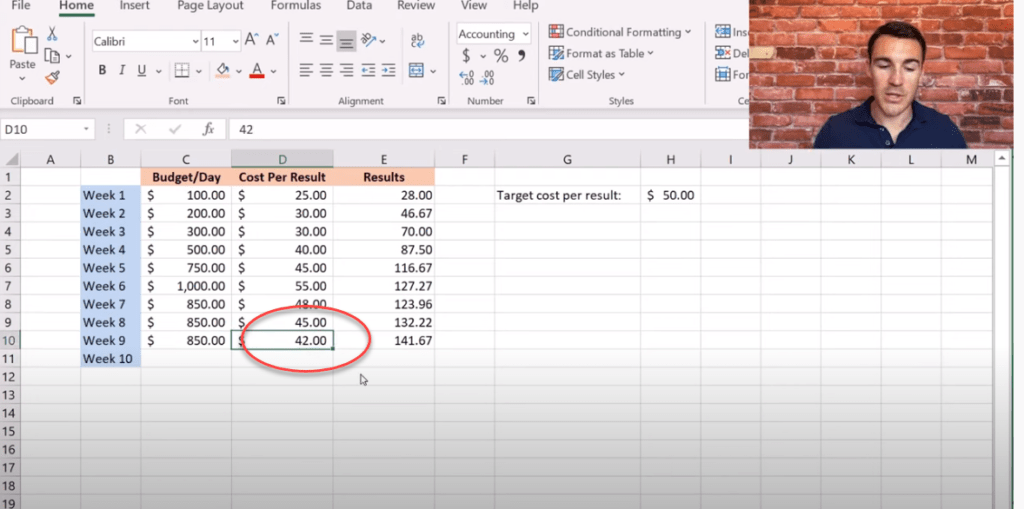
When I see this, I’ll often have another go at scaling. Here I raise the budget up to $1,000 per day and the cost per result goes to $48.
A significant improvement on the $55 cost per result we previously saw at this budget level.
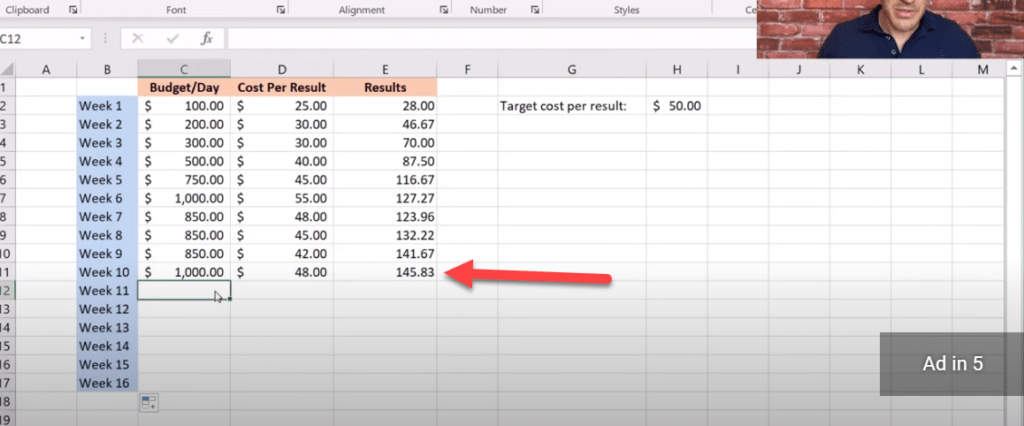
Now, $48 is super close to our upper limit of $50. So we’ll want to stay at this level of spend for a few weeks and go through the same process of monitoring, optimizing and seeing what the results are.
In this case the cost per result drops steadily over a few weeks from $48 to $41.
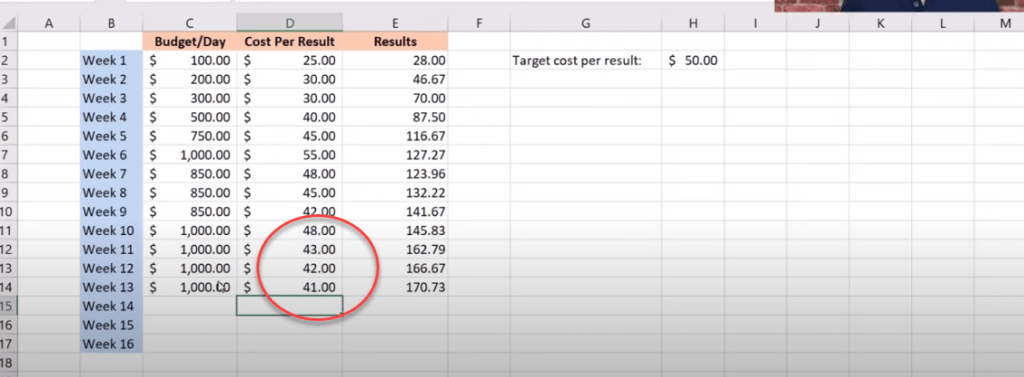
Then we would try increasing the budget again. This time we’ll go to $1,250 spend per day. It turns out this budget increase is too much and our cost per result shoots up to $52 which is too much.
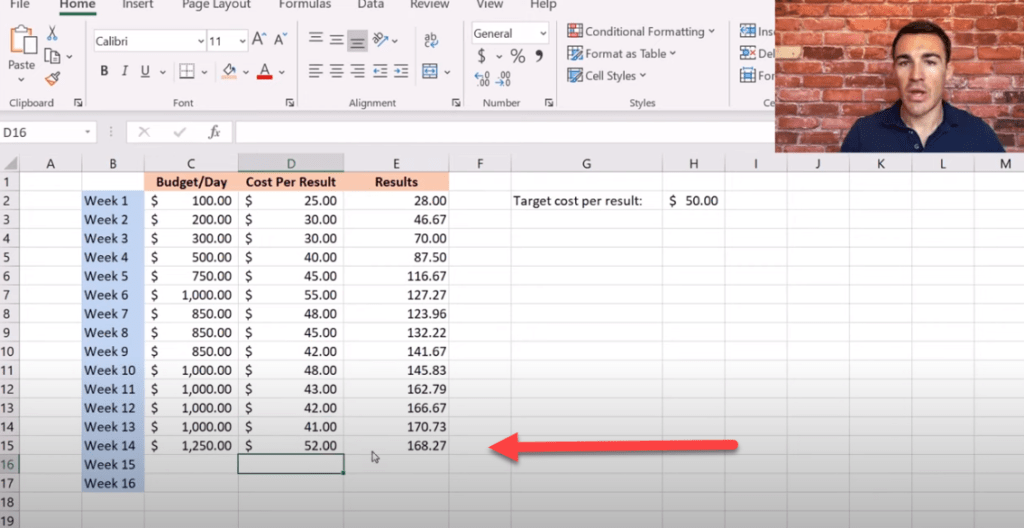
At this point I try a daily budget of $1,100 and see CPR come down to $46.
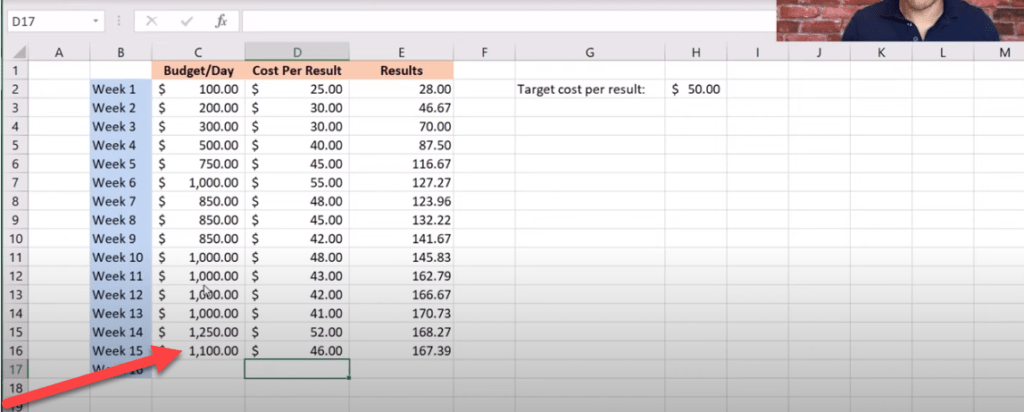
Now, this is data I’m making up, but this is the sort of pattern I see all the time when I’m scaling campaigns.
Scaling isn’t linear, you have to make adjustments as you go along based on the cost per result that your seeing.
As you can see, I’m also not scaling the budget by huge increments at any one time.
You usually can’t take a campaign from $100 a day to $10,000 a day in a couple of months. But it’s certainly possible to take a campaign to over $1,000 a day or 10x your original spend in that sort of timeframe.
The big thing to remember is that you need to be flexible. If your budget goes over the target result when scaling, you often just need to bring it back down a bit.
Also, when scaling you’ll nearly always see your cost per result go up. So you really need to know your numbers and only try to scale campaigns where you have room for that to happen.
Another think I want to mention is that if you hit a scaling plateau, one of the best ways to counteract that is to increase your audience size.
Generally speaking, the larger the audience size is the larger your budget can be.
Also, the more you spend on Facebook ads, the more frequently you need to refresh your creative.
Another Awesome Free Facebook Training Resource
There is nothing I like better than to see business owners increase their ROI with Facebook Ads. In order to help business owners succeed with Facebook ads I’ve created a FREE webinar training that you can register for here.
When you attend this webinar you’ll learn:
- 3 different Facebook ad strategies that we use every day. These strategies have generated millions of dollars in revenue and are tried and proven to work.
- How to customize the Facebook ads strategy to your particular business. There is no such thing as a one size fits all approach to Facebook ads.
- How Facebook and Instagram have changed and how to adjust your ad strategy to what works in 2021.
Video Training On How to Scale a Facebook Ad Campaign
In this 22 minute video I go into depth on how to successfully scale a Facebook Ad Campaign.
The Bottom Line on Scaling Facebook Ad Campaigns
If you have a successful Facebook ad campaign that you want to scale, here are the general rules that I follow:
- Make sure you have some room between your actual cost per result and your target cost per result, because your cost per result will almost always go up during the scaling process.
- You can scale at much higher percentages earlier on in the process.
- Give each daily spend increase a week to settle in before changing it again.
- If your cost per result becomes higher than you want try lowering your spend rather than turning off your campaign.
- You can scale again after a few weeks if your cost per result starts to go down.
Post a Comment
You must be logged in to post a comment.



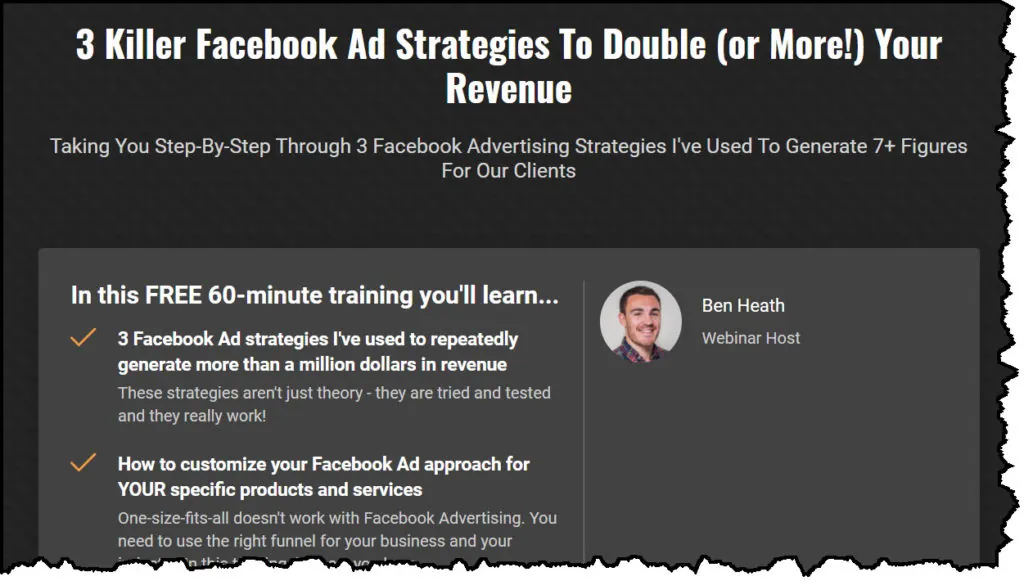

Courtney
Hi there, just stumbled across your site and enjoying reading multiple posts which have all been really helpful thank you. I am just trying out small-scale Campaigns to get a grip with it. I sell a £16 subscription product with an average lifetime value of £112 so calculated my customer acquisition cost at £16. In my most recent FB Campaign, I had 88 link clicks for 4 Orders. In your post above you mention adding a Results column showing how many Leads you generated that week. Apologies in advance if this is a foolish question but is the Leads the same as the Clicks? Although I can see a FB Leads column, it is blank (and so by the way is the conversion column but I am taking the 4 conversions from the URL and/or the Discount Code I added to my various Ads so I can track FB sales as FB Ads Manager seems to fail to record these things). So I am wondering what the Lead column should be recording and whether, if it is blank as in my case, I should just be tracking Cost Per Result against Budget? Many thanks in advance & will plough on reading through your website 🙂
Ben Heath
Hi Courtney, glad to hear it 🙂
Good question but not, leads is not the same as clicks. It sounds like you may have a Pixel tracking issue. Or you could just be not seeing the data because of the iOS 14 discrepancy. As you generate more data, you should get a clearer idea of what the issue is.
20bet
Apoiar ferramentas de apostas e estar equipado com uma plataforma diversificada de transações financeiras, a 20Bet oferece suporte tangível aos jogadores. Este é um lugar onde eles podem apostar com dinheiro real, respaldados por concorrentes de diversas disciplinas esportivas. 20bet